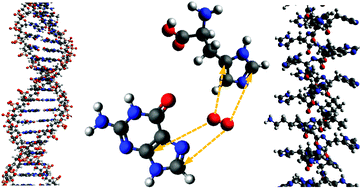An exploration of the reactivity of singlet oxygen with biomolecular constituents†
Abstract
The thermal reaction between biomolecules and singlet oxygen (1O2) is important for rendering the genetic material within toxic cells inactive. Here we present results obtained from state-of-the-art multi-reference computational methods that reveal the mechanistic details of the reaction between 1O2 and two exemplary biomolecular systems: guanine (Gua) and histidine (His). The results highlight the splitting of the doubly degenerate 1Δg state of O2 upon complexation and the essentially barrierless potential energy profile of the thermally allowed cycloaddition reaction when the O2 molecule is in its lower energy 1Δg state.


 Please wait while we load your content...
Please wait while we load your content...